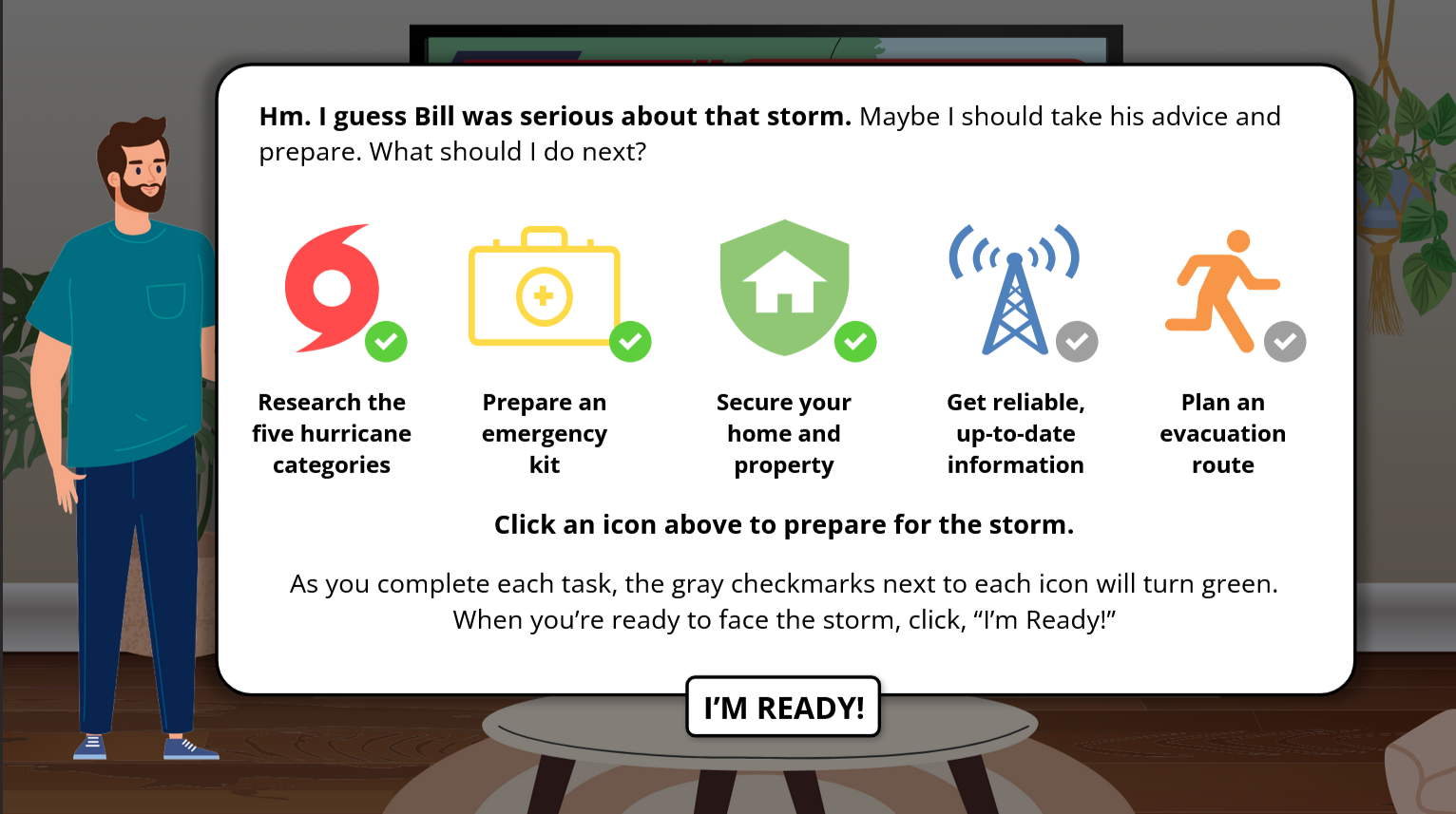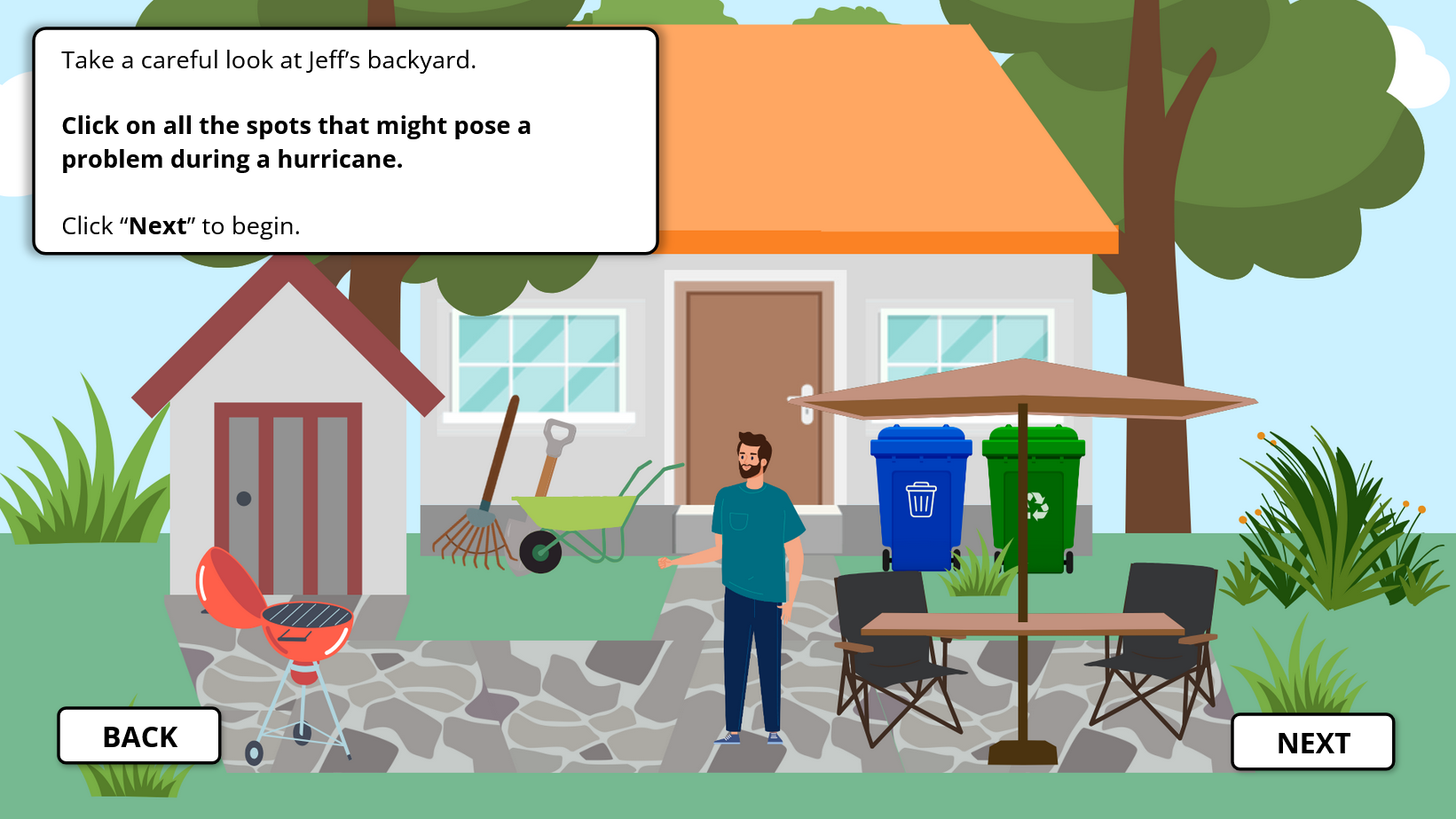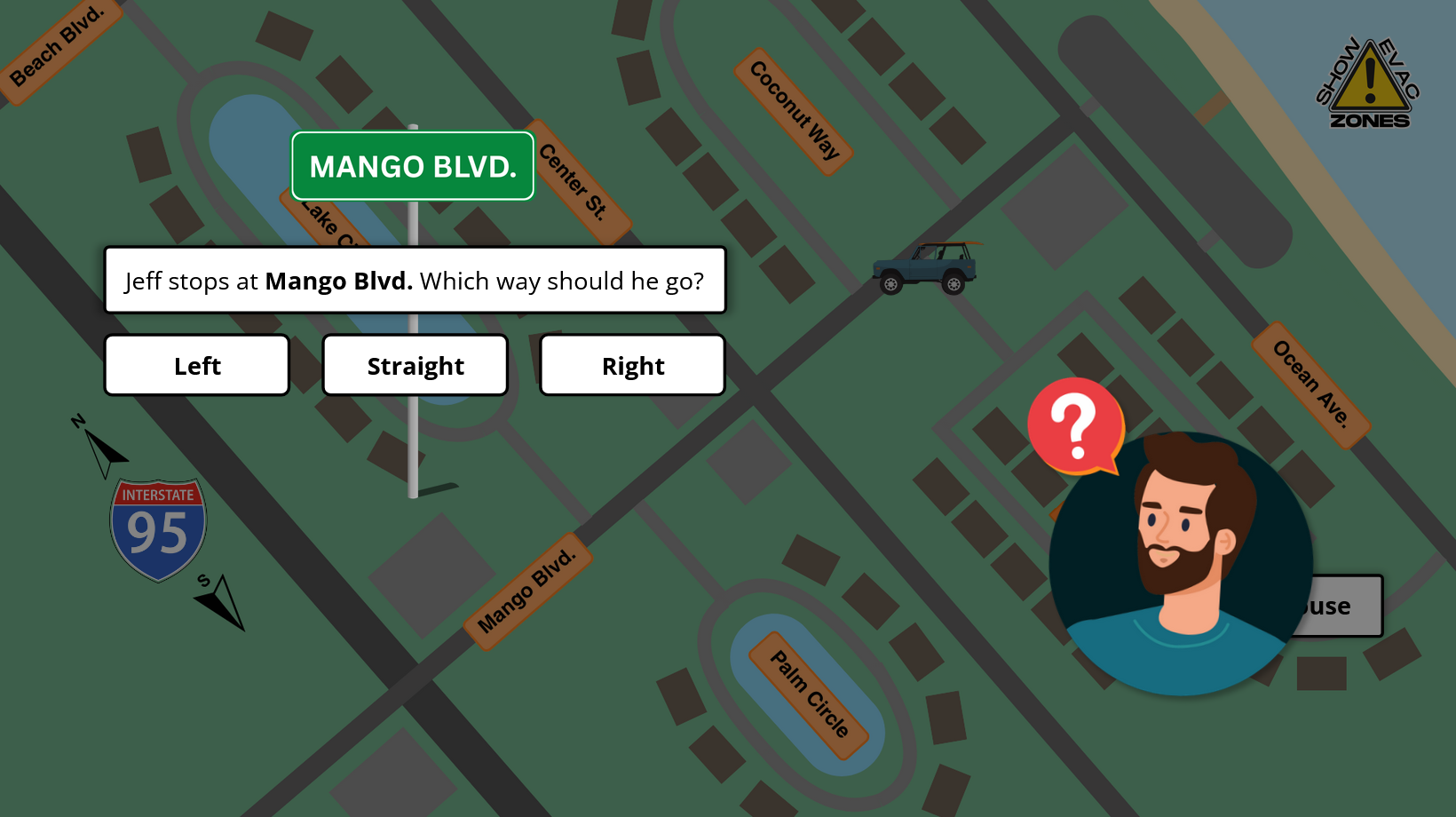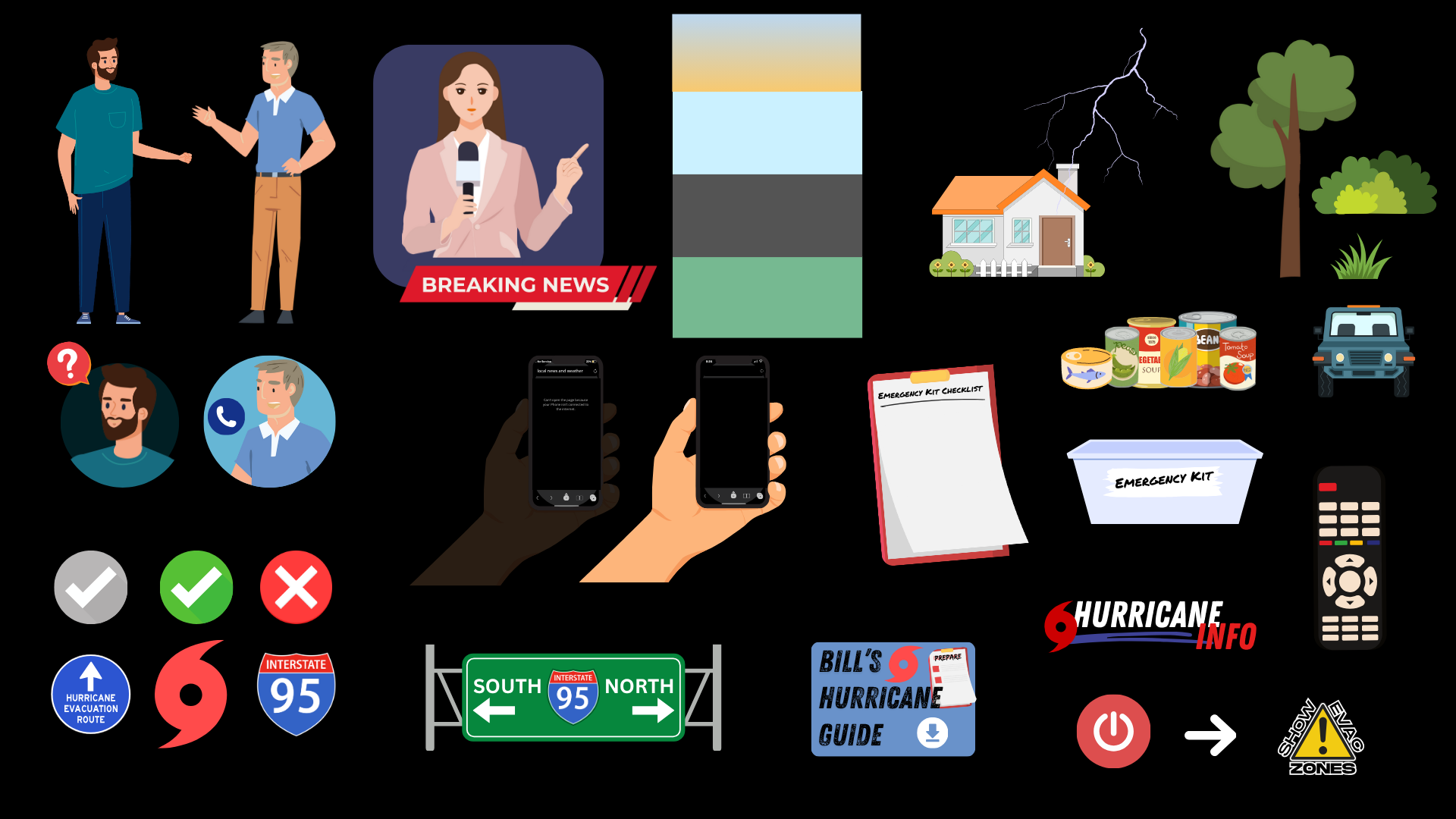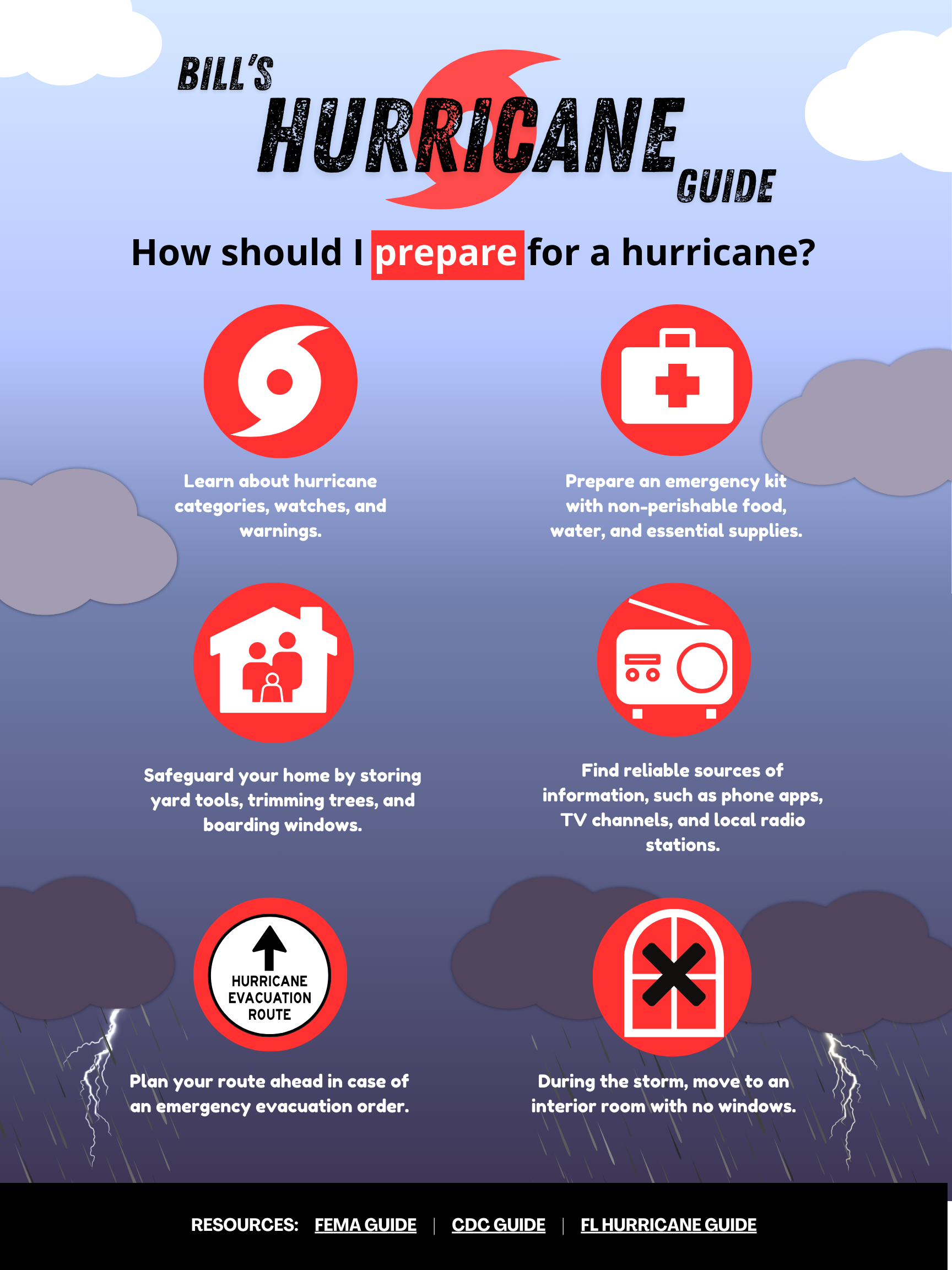Real-world scenarios to prepare for an oncoming hurricane
Post-COVID, Florida has continually vied for the top spot in U.S. population growth. The main draw—warm weather year round—has a price: hurricane season.
Audience
New Florida residents
Responsibilities
Instructional Design, eLearning development, storyboarding, action mapping, visual & graphic design
Deliverables
Outline, storyboard, wireframe, eLearning course, job/home aid
Tools
Articulate Storyline 360, Figma, Adobe Illustrator, Canva, Google Slides, Google Docs
Ideation
The Problem
Since 2020, Florida has continually vied for fastest growing US state. New residents are coming for the weather, but are often unprepared for hurricanes, which can cause catastrophic damage and loss of life. Current hurricane preparation resources are list-heavy and lack scenario-based experiences.
The Solution
A scenario-based eLearning course that puts learners in the shoes of a new Florida resident facing an oncoming storm. Jeff, mentored by his neighbor, Bill, progresses through interactive activities focused on the real-world actions reflecting best practices in hurricane preparation.
Development Process
Analysis began in conversation with a recent Florida transplant in which the gap in knowledge and need for the course clicked. Using Cathy Moore’s Action Mapping—my favored framework for identifying the high-priority actions that will best achieve our desired behavioral change—I began researching and distilling learning objectives. I asked: What are the actions that will best prepare a new Florida resident for an oncoming hurricane?
I created a mind map in Miro to begin outlining: brainstorming key actions, objectives and content—and visualize the flow of the course.
After focused research and consideration, the following learning objectives began to take shape:
• Expand hurricane knowledge (categories, watch vs. warning, damage severity, etc.)
• Create an emergency kit
• Secure and safeguard your home & property
• Find reliable local weather information
• Create and rehearse an evacuation plan
Once I had firmly established the learning objectives, I kicked off the design phase with another favored framework—backwards design. Using the learning objectives, I crafted quiz questions to evaluate those objectives, and pre- and post-assessments to assess knowledge gain and learner confidence. Having both learning objectives and evaluation in place, what sits between them—content—became clear.
I began with a written storyboard in Google Docs, including on-screen text, audio, and descriptions of visuals. Here I drafted the bulk of the content, narrative, and quiz questions. I followed this with a visual storyboard using Google Slides, to begin bridging the text and visual aspects of the project. Adding the visual storyboard allowed the text content to evolve, and distill into its most salient points.
With storyboarding complete, I began developing the project’s visual identity. Through creating and curating multimedia assets in Canva, character, color, and scenery came to life. Once I had a sense of the visuals, I used custom variables in Storyline to develop the interactive scenarios, such as the drag-and-drop emergency kit, and interactive map for the evacuation route.
After learner feedback, l adjusted the home protection and evacuation modules to make them easier to navigate. Also in this phase, I used narrative theory to further develop the characters, plot, and make the experience into a compelling “Hero’s Journey” story.
Finally, I placed periodic quiz questions throughout the experience, reinforcing knowledge, action, and providing feedback to learners.
After completing development, I deployed the course on Netlify, exporting to HTML rather than SCORM or xAPI, for ease of access to public learners. I noticed two issues with the course that weren’t present in Storyline, so I made necessary adjustments to ensure smooth functionality.
I shared the course with (1) a focus group of new Florida residents, and (2) a group of long-term residents who’ve had to prepare for and experience numerous hurricanes. A few learners had issues with access and playback, so after re-confirming functionality on Netlify, I solved those issues personally with learners.
Evaluation begins with key questions:
• Did learning take place?
• How do we know?
• Has it changed real-world behaviors?
In order to find out, I reviewed the data: I analyzed quiz question answers, compared pre- and post-assessment responses, and considered focus group feedback on “Bill’s Hurricane Guide”, the downloadable PDF.
The data showed that learners felt more confident in preparing for a hurricane after taking the course. The PDF guide garnered a mixed response, with some learners citing it as confusing or lacking depth. I reworked it to focus on the key points reflected in the course.
Additional Theory
Malcolm Knowles’ Adult Learning Theory emphasizes that adults are self-directed— autonomous, capable, and bringing their own life experiences to the table. My aim was to develop an experience that provides guidance but respects the learner. Content that is thorough but clear; a story both realistic but fun; graphics friendly but not overly cartoonish; and activities problem-centered and action-oriented. Cathy Moore’s Action Mapping helped identify these essential actions. David Kolb’s emphasis on retention through doing is the main reason I opted for fewer questions and more interactive, engaging activities in this particular project.
Jeff’s story closely follows Jospeh Campbell’s Hero’s Journey: normal life is disrupted by a “call to action” in the form of an oncoming storm. His neighbor Bill serves as a mentor—an older, wiser figure who has been through the “trials” Jeff is about to face. With Bill’s help, Jeff undertakes certain actions to acquire “new skills”, i.e. preparing an emergency kit, safeguarding his home, etc. In the “climax”, Jeff must call upon the skills and tools he’s acquired in order to pass through the “final trial”, Hurricane Alice. He emerges victorious, and returns to normal life, changed for the better.
Another key narrative technique employed in this project is narrative tension. The approaching storm—indicated by narrative updates after 2 and 4 objectives are complete—bring a sense of suspense and urgency that grips the learner and propels them forward.





